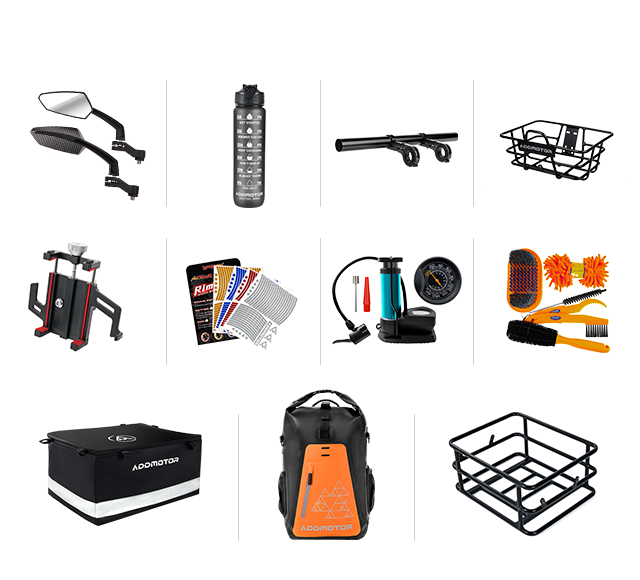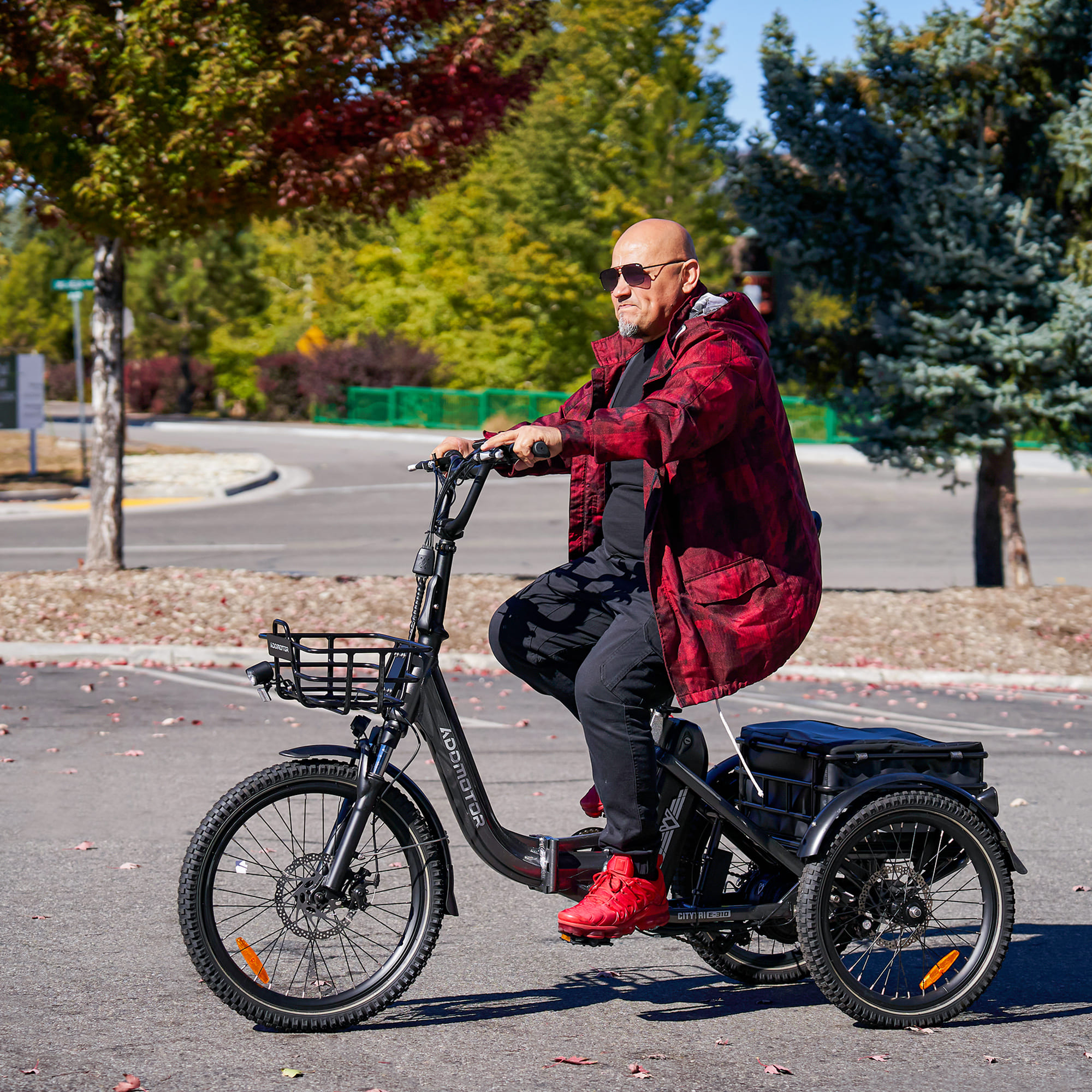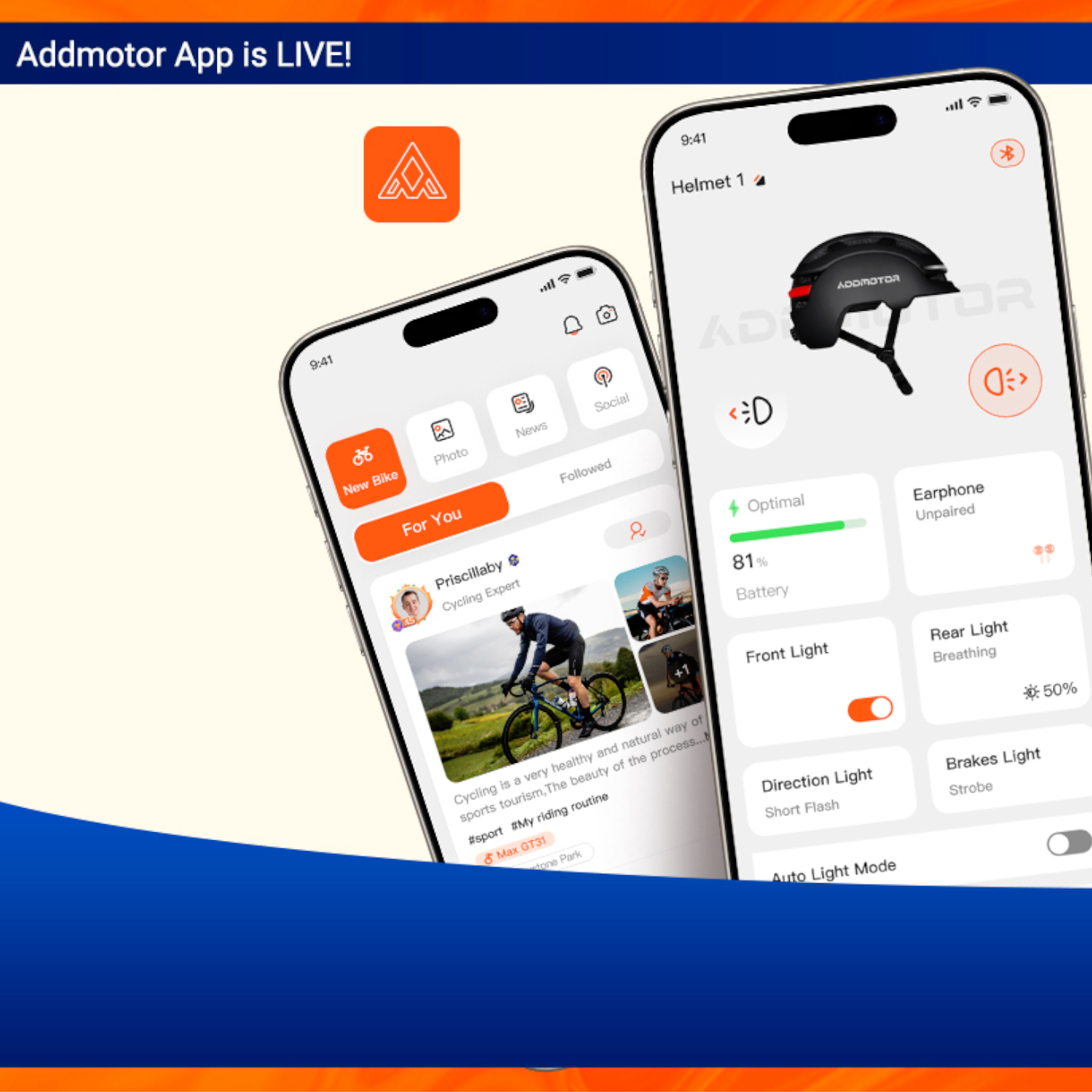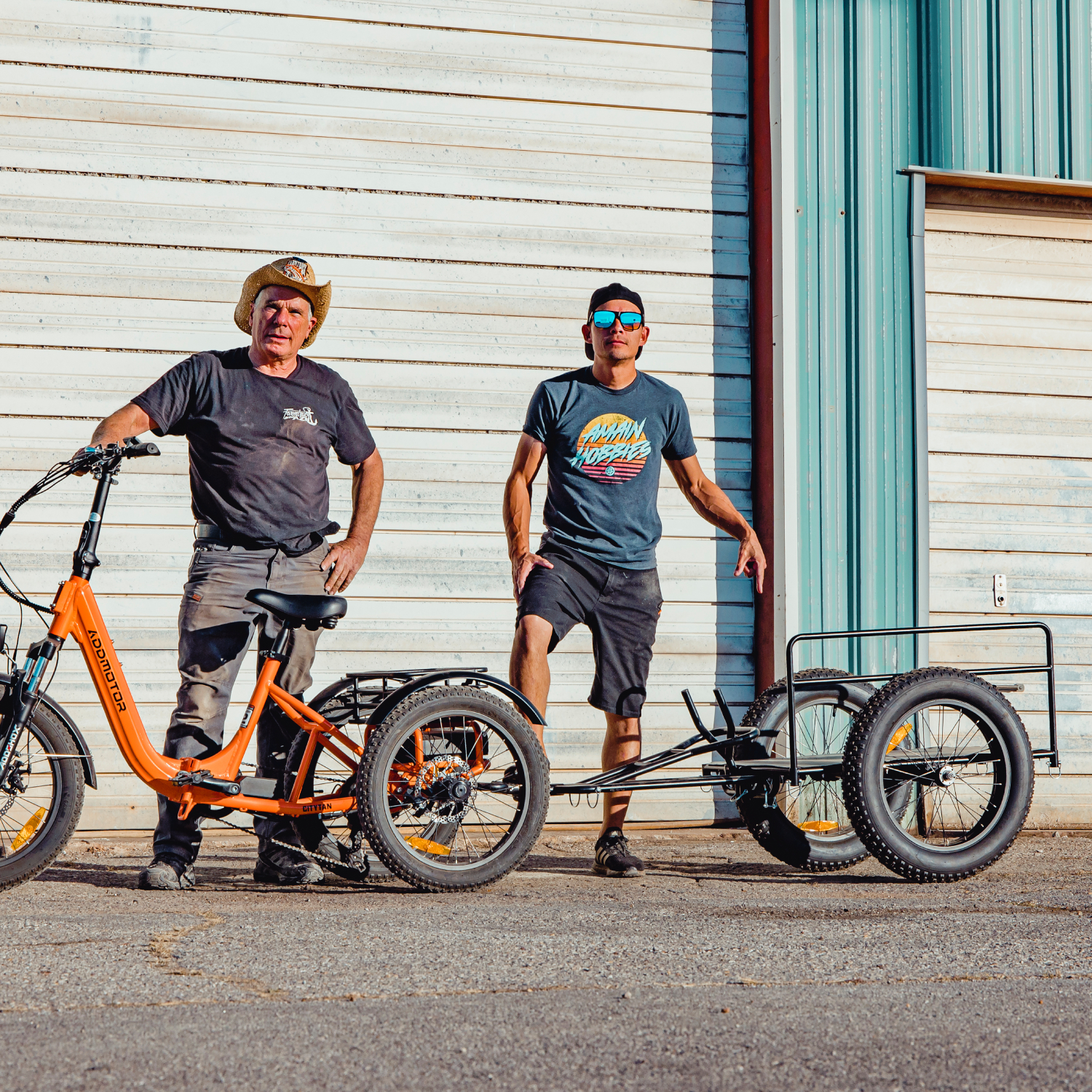Does Electric Assist Make a Difference for Tricycles on Hills?
By Addmotor | 10 May 2025 | 0 Comments
Absolutely—and once you try it, you won’t want to go back.
Hills can be a real buzzkill when you’re riding an adult tricycle. Whether cruising through the neighborhood, exploring a scenic bike path, or just trying to get home from the grocery store, nothing throws a wrench in your relaxing ride like a steep incline.
The climb gets harder, your legs start burning, your knees complain, and if you’re on a standard trike with no motor, it quickly becomes less of a joy ride and more of a sweaty uphill battle.
But what if we told you there’s a way to turn those frustrating hills into something you barely even notice?
That’s where electric assist comes in—and yes, it makes a HUGE difference. It can completely transform your experience with a 3-wheel adult tricycle, especially when the road tilts uphill.
But first, let’s discuss why uphill climbs are difficult on a regular tricycle.

For older adults or those with cranky knees, a history of back flare‑ups, or a sciatic nerve that likes to remind them who’s boss, this kind of strain isn’t just uncomfortable, it’s unsustainable. You might feel motivated for the first hill, but by the second or third? You’re probably ready to pack it in and call a cab.
This is one of the biggest limitations of traditional adult tricycles: they’re stable, yes, but they still require a strong pedaling effort, especially on slopes. And while a multi-speed drivetrain helps, it’s no match for gravity when your joints are yelling at you.
Because the motor senses crank cadence and/or torque, it blends seamlessly with your pedaling. Instead of replacing exercise, it amplifies it. Your heart still pumps, but your joints stop complaining. That means:
With pedal assist, those routes are suddenly back on the menu. This boosts ride frequency and is arguably the best “fitness feature” on spec sheet lists.
Studies show that e-bike (and e-tricycle) riders still hit moderate-to-vigorous heart-rate zones, just with less perceived exertion. This encourages consistent weekly mileage, which is key for heart health, weight control, and mood.
Plus, you can dial the help up or down. Want a leg workout? Drop into Eco or disable the motor on flats. Ankles barking after mile 15? Bump it to Turbo for the next climb and glide home smiling.
Here are three spec cues to scan on any electric tricycle product page (Addmotor’s lineup included):
Q: Does an electric motor make an e-tricycle feel unstable at climb‑out speeds?
A: Not at all. Motors add smooth, predictable thrust. In fact, the faster roll often improves stability by giving the steering more gyroscopic effect.
Q: Will the battery overheat on long, slow mountain ascents?
A: Quality packs include thermal management. As long as you ride within the maker’s recommended assist levels and keep airflow around the case (don’t wrap it in a jacket!), you’ll be fine.
Q: What if the battery dies halfway up?
A: You’re back to a regular 3-wheel adult tricycle—heavy, yes, but still rideable. That’s why we always advise carrying the charger on day trips and watching the LED fuel gauge like you watch your gas tank.
If you live in a flat area and only ride short distances now and then, maybe a non-electric trike with 7 gears will do. But if there are hills in your area—or you want to ride longer distances with less strain—then yes, absolutely, an electric assist will make all the difference.
Could you conquer that climb on a non-assist tricycle with enough gears and grit? Probably.
But why muscle through when a discrete motor can transform the task into pure fun and make you want to do it again and again?
That, friends, is the difference that keeps wheels turning long after the first summit.
At Addmotor, we have a huge collection of adult electric tricycles with 5 to 7 PAS levels. Each model is designed to turn knee-grinding grunts into breezy conversations, keep cargo-hauling safe and steady, and open ride routes you might have erased from the mental map.
Here’s to smoother climbs and bigger adventures on every electric tricycle ride!
Hills can be a real buzzkill when you’re riding an adult tricycle. Whether cruising through the neighborhood, exploring a scenic bike path, or just trying to get home from the grocery store, nothing throws a wrench in your relaxing ride like a steep incline.
The climb gets harder, your legs start burning, your knees complain, and if you’re on a standard trike with no motor, it quickly becomes less of a joy ride and more of a sweaty uphill battle.
But what if we told you there’s a way to turn those frustrating hills into something you barely even notice?
That’s where electric assist comes in—and yes, it makes a HUGE difference. It can completely transform your experience with a 3-wheel adult tricycle, especially when the road tilts uphill.
But first, let’s discuss why uphill climbs are difficult on a regular tricycle.

Hills and Human Power: Why They Feel Tougher on Three Wheels
Adult tricycles have:- Extra weight in terms of a third wheel, sturdier frame, and sometimes a rear basket full of groceries or a furry co‑pilot.
- A wider profile that grabs more rolling resistance on rough pavement.
- A sit‑back posture that’s fantastically comfy on flats but robs you of the “stand and crank” leverage bikers use on rises.
Pedaling up a hill on a regular trike without electric assist takes a LOT of effort. You have to push on your knee to give yourself extra strength, and even then, the hill may feel like a monster. Your speed will drop, your body will start to ache, and the strain will become painfully obvious, especially on longer rides or when doing multiple hills back-to-back.For older adults or those with cranky knees, a history of back flare‑ups, or a sciatic nerve that likes to remind them who’s boss, this kind of strain isn’t just uncomfortable, it’s unsustainable. You might feel motivated for the first hill, but by the second or third? You’re probably ready to pack it in and call a cab.
This is one of the biggest limitations of traditional adult tricycles: they’re stable, yes, but they still require a strong pedaling effort, especially on slopes. And while a multi-speed drivetrain helps, it’s no match for gravity when your joints are yelling at you.
Climbing a Hill With vs. Without Electric Assist
If you climb the same hill twice (one ride with the motor turned off, the next with it on), you’ll notice the following differences: (take Addmotor Grandtan e tricycle as an example)| Motor Off (7-speed drivetrain only) | Motor On (7-level pedal-assist mode) | |
| Start‑up torque | Leg-powered only; sluggish on ramps | Instant wheel turn, even in low assist |
| Mid‑hill speed | 3–4 mph crawl; heart rate redlining | 12–14 mph cruise; rider still chatting |
| Body strain | Knee push, back lean, sciatic twinge | Upright spine, light pedal pressure |
| End‑of‑ride vibe | “Need a snack and a nap.” | “Let’s do another lap.” |
How Electric Assist Flattens the Hill
Modern electric tricycle drive systems add power in measured doses. Most let you pick from three to five levels:- Eco (PAS 1-3) – Provides light, energy-efficient support that’s ideal for gentle slopes or extending battery life; it takes the edge off without doing all the work for you.
- Tour/Normal (PAS 4-6) – Offers a balanced boost that feels natural and steady, perfect for moderate hills or everyday riding with a bit of added power.
- Turbo (PAS 7) – Delivers maximum assistance for steep inclines or when you’re tired; this setting can make challenging hills feel nearly flat and effortless.
- Longer rides before fatigue hits.
- Steadier cadence so muscles fire efficiently.
- Fewer stops to rest halfway up.
Real‑World Wins for Everyday Riders
1. Joint-Friendly Climbing
Many folks choose a 3-wheel adult tricycle precisely because balance or joint issues make two-wheelers iffy. Electric assist protects fragile cartilage by trimming peak force on every pedal stroke. It takes the strain off your knees, hips, and lower back for smooth, supported movement.2. More Ride, Less Fatigue
Without a motor, hills can wear you out fast. With assistance, you can ride farther and longer without feeling like you’ve been through boot camp.3. Adjustable Effort Levels
The option to choose your level of help means you’re always in control.4. Conquering the “Confidence Gap”
Ever skipped a scenic route because you remembered a gnarly hill near the end?With pedal assist, those routes are suddenly back on the menu. This boosts ride frequency and is arguably the best “fitness feature” on spec sheet lists.
5. Carry More, Worry Less
Whether it’s groceries, picnic coolers, or the family spaniel, cargo adds weight fast. A motor shrugs at the extra pounds and keeps speed steady so steering stays predictable.But Wait—Isn’t Exercise the Point?
Contrary to myth, pedal assist doesn’t turn riding into a joy‑stick cruise.Studies show that e-bike (and e-tricycle) riders still hit moderate-to-vigorous heart-rate zones, just with less perceived exertion. This encourages consistent weekly mileage, which is key for heart health, weight control, and mood.
Plus, you can dial the help up or down. Want a leg workout? Drop into Eco or disable the motor on flats. Ankles barking after mile 15? Bump it to Turbo for the next climb and glide home smiling.
Choosing the Right Assist System
Not all motors feel the same.Here are three spec cues to scan on any electric tricycle product page (Addmotor’s lineup included):
| Spec | Why It Matters on Hills |
| Nominal wattage | 500W is plenty for most slopes; 750–1000W flattens the steepest streets. |
| Battery amp‑hours | Bigger packs (e.g., 20 Ah) mean you can stay in higher assist mode longer without range anxiety. |
| Torque sensor vs. cadence sensor | Torque‑based units feel more “natural,” giving power proportional to effort, which is especially nice for gentle starts on an incline. |
Frequently Asked Questions
Q: Does an electric motor make an e-tricycle feel unstable at climb‑out speeds?A: Not at all. Motors add smooth, predictable thrust. In fact, the faster roll often improves stability by giving the steering more gyroscopic effect.
Q: Will the battery overheat on long, slow mountain ascents?
A: Quality packs include thermal management. As long as you ride within the maker’s recommended assist levels and keep airflow around the case (don’t wrap it in a jacket!), you’ll be fine.
Q: What if the battery dies halfway up?
A: You’re back to a regular 3-wheel adult tricycle—heavy, yes, but still rideable. That’s why we always advise carrying the charger on day trips and watching the LED fuel gauge like you watch your gas tank.
So, Should You Get an Electric Tricycle?
If you live in a flat area and only ride short distances now and then, maybe a non-electric trike with 7 gears will do. But if there are hills in your area—or you want to ride longer distances with less strain—then yes, absolutely, an electric assist will make all the difference.Could you conquer that climb on a non-assist tricycle with enough gears and grit? Probably.
But why muscle through when a discrete motor can transform the task into pure fun and make you want to do it again and again?
That, friends, is the difference that keeps wheels turning long after the first summit.
At Addmotor, we have a huge collection of adult electric tricycles with 5 to 7 PAS levels. Each model is designed to turn knee-grinding grunts into breezy conversations, keep cargo-hauling safe and steady, and open ride routes you might have erased from the mental map.
Here’s to smoother climbs and bigger adventures on every electric tricycle ride!
Leave a Reply
Your email address will not be published.Required fields are marked. *
Latest Stories




